-
Posts
1,630 -
Joined
-
Last visited
Content Type
Profiles
Forums
Store
Help Articles
Posts posted by markk
-
-
Isn't this actually "Upside-down Tamarind Shrimp"?
-
The Italian word for it is "coperto", and as it was explained to me by an Italian restaurateur, the "cover" charge on your bill in an Italian restaurant, usually listed as "pane e coperto" but somtimes simply called the "coperto" represents the restaurant's cost of setting a place for a dinner, whatever costs are involved in the laundering of the cloths and napkins, the cost of washing the silverware, the glassware, filling the bread basket, etc. And they also use the term to mean the number of people dining, the same as we're using it (we did so-many "coperti" tonight). As to whether the cost of setting the place is the official origin of the term, I can't say for sure, but believe it is too.
-
markk,
Well, it appears as if you've done all you can. The restaurant has chosen to apply their policy without discrimination or favoritism. And it appears as if you're going to keep going back anyway.
Well, I was just curious what people thought of the situation. I didn't want to do anything about it. The Restaurateur's "art" always fascinates me, including why some restaurants will flourish and others nearby with equally good food will die.
As it turns out, we've pretty much stopped going there, but entirely because we've found other places whose food we enjoy more. It has nothing to do with the second corkage fee.
And it has nothing specifically to do with another story that I had completely forgotten until today; we dined there one night and were told that the special that day was Sea Bass, which we've had there before and loved very much. When it came this time, it actually was "Chilean" Sea Bass, which we don't like. We noticed it as we were eating it, and as we didn't enjoy it, we basically just picked at it. As I say, we order so many courses (frequently three appetizers to share amoung the two of us) that we were pretty full, and decided not to send them back and wait for something else at that point. But when she cleared the plates and saw that we hadn't eaten much of it, she asked if we didn't like it, and we said that, in fact, no, it was actually "Chilean" Sea Bass, which we don't like. Her reply was, "Yes, I didn't make that clear" and made no attempt to remedy the situation in any way, and charged ($36 dollars each) for them. Of course, we chose not to send them back or make an issue of it, but again I think a restaurant should be somewhat gracious about regular customers not eating their food because they don't like it, and we thought her attitude over the wrongly described food was pretty cavalier under the circumstances. Exactly what she should have done, I can't say, but leaving it as she did didn't exactly create a winning feeling either.
But I can't say that that's specifically how she lost us either. When we're on vacation, we always try some new (to us) restaurants in the mix, and have recently found some that we enjoy a lot more, so for our last two trips, she lost us as customers by attrition. Her lack of a "gracious" attitude didn't actually drive us away, but when we found newer places that were more enjoyable all around, when it came time to choose a restaurant for dinner each night, her place just never came up. That's life, I guess. I think you called it right earlier.
It's all on how you handle it, I guess. Even so, some places will stick by their policy no matter what, customer relationship and loyalty building be damned. -
I don't know, if the owner is waiting tables, y'all are the only diners sometimes, never seen the place more than 2/3 full, dude, they need all the corkage fees they can get.
That's very true.
Somehow I think that by going there as often as we do when we're in town, and by ordering such elaborate meals, and by tipping very generously, we're certainly showing our support of her.
It's just that, from a "gracious" point of view, as DutchMuse called it, it strikes me as oddly not (gracious). And now that we think about it, there are no gracious touches in this place, which is odd for a French restaurant.
-
I don't know about New Jersey, but my understanding is that, at least in New York, it's illegal for a restaurant to permit you to open a bottle of wine WITHOUT a corkage fee.
The restaurant's in Florida, and I don't know what the law is there, nor can I find it on-line, so I'll call the Florida ABT offices on Monday. If the law says that they must charge the fee for each bottle opened, that would certainly change my thoughts on the matter.
-
Yes, it would be a gracious gesture but were I in your shoes, I wouldn't necessarily expect it.
And indeed I don't expect it (a gracious gesture). I go back anyway knowing we'll pay a second corkage fee for the last two glasses of wine, and the more times we go in week, and the more regular we become (
 ), the odder I find it.
), the odder I find it.Edited to add: I think you've hit the nail on the head and found why I find it odd. Over the years, I've come to associate French dining, specifically bistro dining, with gracious gestures, and warm hospitality. And there's none of that in this place, ever.
-
My first question is what kind of relationship have you established with the restaurant staff and management? Do they know you always visit multiple time when in town? Do they know how much you like their place? Or are you just two other customers?
What kind of wines are you bringing? Are they priced similarly to the ones on the list?
Do you call ahead and ask to bring your own or just show up with it?...
It's all on how you handle it, I guess. Even so, some places will stick by their policy no matter what, customer relationship and loyalty building be damned.
This is such a tiny place that some of your questions regarding the "staff" don't apply, because the owner waits the tables, and there are two people visible in the kitchen you see through a large pass when you go down the hallway to the bathrooms, and that appears to be it.
The owner very definitely knows that we're from out of town, how long we're there for (usually a week at a time), and how many times we come in a particular week/year. (She's the only one serving customers.) And she knows that we've traveled extensively in France, and come to her place because we like the food.
Do I just show up with wines? No. As I do before going to any new restaurant whose menu and wine list aren't on line, I stopped by in advance of the first time to check out both. The wine list was one of those that seems to have been chosen for them by a wine rep, you know, there'll be a generic "Cotes du Rhone", a "Macon Villages", no wines chosen for how they'll taste with the food, just 6 obligatory reds and 6 obligatory whites. So after looking at the list, I asked if they had a corkage fee, and she replied that it was $15, which is perfectly fine with me.
Do I bring wines that are better drinking than are on the list? (I don't think you specifically asked this, btw.) Yes, most definitely. Are they more expensive bottles than they sell? No, and they don't actually have to be, considering how ill-chosen theirs are (well, this will make sense to you, Brad, and probably to most people these days).
Do I share? Indeed, I insist on it. I don't want to come right out and say "Lord, your wine list is terrible!", but I do want her to taste what better wines taste like (the surprise these days being that they can even be moderately priced). But I've even brought wines that are definitely cheaper (and better drinking) than their "Macon Villages". And though I don't do it for the expectation of anything in return, I always suggest (I stopped after the first dozen times because I figured by that point she knew I meant it) that either she and/or the kitchen people enjoy the remaining wine, which I leave because I don't want to drive with an opened bottle in the car.
And of course, it's not the corkage fee that I'm questioning. I love corkage fees and the opportunities it opens in many situations.
To get back to your questions: It's more than clear to her that we come a lot because we enjoy their food but can't drink their wines. I guess the part that just strikes me as strange each time is that it's the owner who sees that we've opened a second bottle just to have a glass with dessert, and puts the second charge on. Technically she's totally in the right, and my original post was not a complaint.
(I also definitely do not equate sharing wine with a restaurant to negate a corkage fee. I wouldn't expect a restauant to waive a charge because I shared wine with them. Unrelated, I've been in lots of situations in restaurants I frequent where the restaurant has a corkage fee and I've ordered a bottle of their white to start, and brought my own red from my cellar to drink with their food, and they don't charge a the corkage - why in that case I don't know, but it happens. It's not something that I expect if I know they have a corkage fee, either.)
As I say, this restaurant owner is in the right to charge her stated corkage fee, and I wasn't complaining. I was just saying that it strikes me as odd under the circumstances for her to charge the second one (they're hand-written bills, by the way, which I haven't seen in years) when the we're only opening it to have a glass of it. Even if I took the wine home, I'd still find it odd under the circumstances.
You caught the gist of my sentiment exactly:
It's all on how you handle it, I guess. Even so, some places will stick by their policy no matter what, customer relationship and loyalty building be damned. -
I'm already afraid that I can't explain this right, but I'm going to try. It really isn't about getting something for free from a restaurant, but rather about restaurant philosophy as it pertains to creating goodwill with regular customers.
So with the understanding that I'm probably going to bungle this, here's what we were thinking...
There's a restaurant that we go to regularly on vacation. It's a small, local French bistro, and it's never anything like crowded. It's got about 32 seats, and frequently we'll be the only table dining (two peope), and I've never seen it more than a third full.
We like the food, which is why we'll go three or four nights on a week when we're in town. Their wine list is just horrible, though. It's got 12 selections, 6 red and 6 white, and it's as bad as one that you might find at a mediocre chain restaurant. (They're not serving Ecco Domani Pinot Grigio, but they are serving French equivalents.) Certainly nothing that would be enjoyable to drink. So we bring our own, and pay the $15 corkage fee.
And we eat up a storm. We always have multi-course dinners, and always their most expensive, daily-special items. (The restaurant's not exactly cheap.) We have noted with curiosity that a lot of people come in, have an inexpensive main course and split a dessert, and leave, while we're running tabs that are easily three times that for the same number of people, two. (We only notice this because people are in and out while we're still in the middle of our meal.)
And we always move onto a second bottle of wine, which we never come close to finishing.
(Wine glasses are not a factor here; they have basic, non-crystal one-size-fits-all glasses, and you stick with your glass all night.)
It always strikes me as strange that they charge a second corkage fee. It's really not because I want something for free, I promise, just that maybe I'm used to restaurants who in some way or other do something thoughtful for their regular guests. What makes me think of this is that I surely understand why a restaurant would charge a corkage fee- there's a profit on a bottle of wine that they don't make if you don't order wine from them. I'm all in favor of that.
But I usually think, and see that the average table, if they order wine at all, don't drink a second bottle. And just from the many gracious things I've seen restaurants do, I'm wondering why, once you've made your corkage fee on the first bottle in a local, simple place, why you wouldn't think to waive the second fee on a table of people who always come when they're in town - when you see that they've opened the second bottle just to have a glass of wine with dessert. (When they go to pour it after that, we stop them since we don't want more, and they know from clearing our tables that there's alsays more left in the second bottle than we drank.)
Again, it's not that I want something for free. And if in any way we wanted to save a second corkage fee, we'd make one bottle last the whole meal, which we have no interest in doing. It just strikes me as a hospitality oddity each time it happens.
And now, with great trepidation, I ask: any thoughts on this?
-
I've not seen mention of it yet on this thread, but I used the (bright orange) 'I ristoranti d'Italia 2006 (Le Guide de L'Espresso)' on a series of trips in the last year or two.
Thank You !!!
-
The simple wines of that region, the Pinot Blancs, are just spectacular, and as everybody notes, you quaff them in great quantities with the tarte flambée. The particular town that we used to go to is Dahlenheim, 13 miles from Strasbourg, which is in the Bas-Rhin. Just about all of the famous wineries of Alsace, and just about all the wines imported to the US come from the Haut Rhin. But the unknown wines of the Bas-Rhin are stunningly delicious. The first time we went to Dahlenheim, the restaurant sold its own Pinot Blanc, and we bought a dozen liter bottles to take home; they were less than a dollar. The restaurant was afraid to sell them to us because they didn't have an export license (totally irrelevant), and they finally agreed to sell them to us without labels. Those wines were absolutely delicious a year later. On subsequent trips we've visited other wineries there that were literally in people's garages and had wines more delicious than can be described. (They don't limit themselves to Pinot Blanc, but that's what's usually poured with the tarte flambée.)
-
Oh, you're very welcome!
Here's where that slice came from. Alsace is one of the places on earth known as the "pastry crust capital of the world" (I'm sure there are others), and things in tarte shells, and things "en croute" are an obsession there.
Here's a long view of the bakery display, and then a close-up. Sadly, it was late in the day, and the display was mostly all gone.
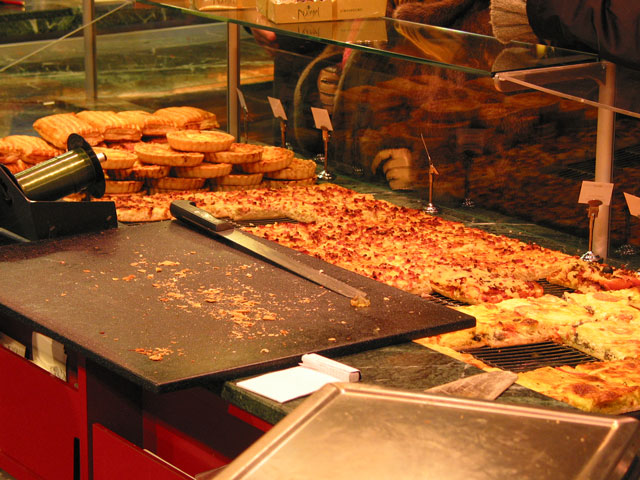
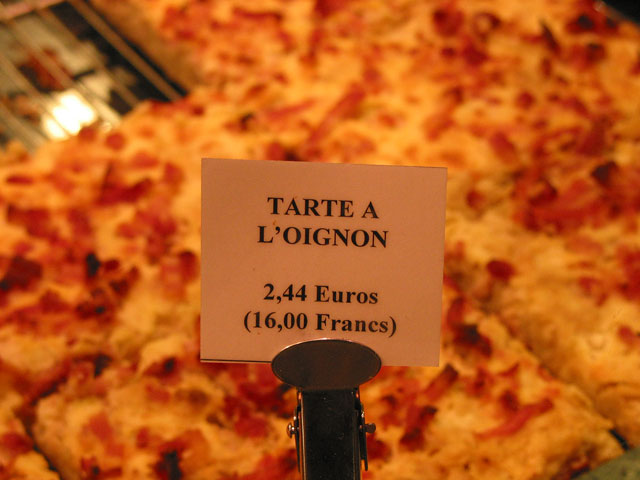
Then there's also the flaky (puff) pastry obsession as opposed to "short" pastry obsession. Here's a video of an apple tarte at a favorite restaurant in Alsace that was so crunchy that one night we asked everybody in the restaurant to be quiet for a moment so we could film it to hear the crust!
(For a little more description, it's from this page of my Alsace diary.) I'll get the tarte flambee videos up later.
-
He's famous for that, but it is absolutely not the traditional Tarte Flambée because he's using puff pasty, not bread dough. (Still, it's incredibly delicious, of course, whatever it is!)
Another difference is that the onions and bacon are not precooked, nor does the tart bake for more than a minute, because the oven is so hot that everything cooks in precisely one minute. However, those are just adaptations for a standard oven.
I found a great NY Times article about Tarte Flambee.
I'm going to try to dig out my video of the visit to the Tarte Flambée oven and post it later.
-
You're welcome!
I did some googling and found you a perfect photo of a Tarte Flambée
They also make a dessert version of it (oh, those French). The dough and cream layer are the same, but then it's topped with thinly sliced apples and sugar before it goes in the oven for a minute.
At most places, the oven has traditionally been in a little shack behind the restaurant, as it was in the first place we went to, and as it was winter in Alsace, the cooked tarte has to be carried from the hot oven through the outdoor courtyard to the restaurant. Still, it arrives sufficiently hot at the table that when they pour a bit of Calvados over this one and light it, it bursts into flames. Then with the flames going, they sprinkle it with sugar and cinnamon, and you get a sparkling effect until the flames go out. And it's sooooo delicious! (And again, this should not be confused with the other Alsatian Apple Tart, which is made, just like the other bacon-and-onion tart, in a flaky crust shell filled with an egg-custard with apples. That's another one you could make very easily for your meal, actually.)
-
A question I ask from time to time, hoping oh so much that it will trigger a memory in someone...
Does anybody remember a "pudding" product that was a big munchie favorite in the late 60's and early 70's? It was sold in the supermarket in plastic tubs, and the traditional method of enjoying it was to pass the tub around with a spoon in it. But then we all discovered that apparently something in saliva made it break down, and so with the repeated dipping of the communal spoon into it, at one point it went from hit-the-spot pudding to a strange mess.
Does anybody remember the name of this product?
-
Curried Lamb Balls
-
2. The eGullet Forums are media. They likely have more impact than many other forms of food and restaurant focused media. eGullet and similar discussion forums are unique in that their content is not generated by editorially supervised writers. As a result guidelines, other than those in a forum's membership agreement, have not been developed or adopted. Not sure they ever can be. Which calls for self responsibility - a self-imposed sense of fairness. To paraphrase Cornell University's motto, "with freedom comes responsibility."
3. The velocity and immediacy of the internet does not take away one's duty to be fair and responsible. Such obligation should not change just because it takes minutes not days to publish.
No disrespect intended here, either, but as a gulletteer who has been following this thread since the first, catchy-titled post, I found the original post both fair and responsible. He made it clear at the outset that he was ranting, and he was also fair enough to point out that his gripe was over the fact that he'd been charged money, more than it was simply a post about disappointing food.
And the fact that eGullet forums may have more impact than other forms of media should serve perhaps to put restaurants on their guard more than posters; for better or worse, (better, I think) eGullet is a part of the dining culture now - if you're going to throw open your doors for business and charge customers full price for your offerings, you should beware that any of them may likely be a gulletteer who's going to post about the meal as soon as it ends. If you feel that you need more time to get things right, you should delay your opening, or offer reduced-prices during a soft opening period.
But for a member to post as responsibly as the OP did is a remarkable testament to his fairness. He gave full disclosure of anything and everything that could have prejudiced his opinion of the experience, and his comparison to similarly priced establishments was completely in fair-play.
-
I spend a lot of time in Alsace for the purpose of eating, and have devoted much (happy) time to this question, so here goes.
They're different items, both traditional. The tart you're probably referring to is called "Tarte a l'Oignon", and it's a tart shell filled with a custard of eggs, cream, onion, and bacon. The shell is made of "pâte brisée", which is a "short", or flaky pastry dough, of course not sweetened.
The pizza-like item you're referring to is a "Tarte Flambée". On my first two trips I thought the names were interchangeable, and eventually did some serious asking. The reason for my confusion is that a lot of bakeries will make the "Tarte a l'Oignon" in a giant rectangular pan, and sell it by the slice, which they also do at the many outdoor markets in Alsace at Christmas time.
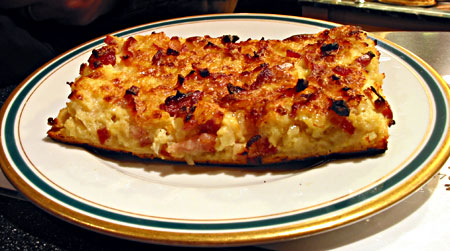
(Tarte a l'oignon)
When I began my research in Strasbourg, I was told "no, you can't eat Tarte Flambée in the city - it's a country dish and you have to drive out of town to experience it."
So the hotel suggested a tavern about 30 minutes out of town and gave me directions, and called ahead to let them know we were interested in learning about Tarte Flambée, and after we ate our first one, they took us out back to the little shack with the oven and explained it all to us.
The Tarte Flambée starts with a small bit of bread dough - no yeast, and no oil, and is rolled out as thin as possible - in fact, even the smallest places now use a machine with rollers because you want it a little thinner even than is easily done by hand. The dough is spread with a well creamed mixture of Fromage Frais (a fresh cheese similar to cottage cheese) and crème fraîche (the two are blended together until smooth), and then it's topped with chunks of bacon, and slivers of raw onion.
It goes into a blistering hot wood burning oven for a maximum of 60 seconds, where as soon as it hits the oven it starts buckling, and the edges start to char (hence the name 'flambée) and it's cooked and out in one minute. The countryside is dotted with taverns that have signs advertising "Tarte Flambée at Night" - traditionally, restaurants in cities don't serve them, and traditionally they're only served at night.
The two are never confused in Alsace. The "tarte a l'oignon" is made its way with a flaky crust and a custard, and the "tarte flambée" is made with an unleavened bread dough with no oil or fat.
I'm sorry I don't have photos of "tarte flambée" - the day we had this adventure, we had the video camera with us, although you can google photos of it. It looks like a rustic pizza, and after it's sliced, it's traditional to roll the slices to eat them - they would otherwise droop when you go to pick them up.
Unless you have a blistering hot wood burning oven, you're better off making a "tarte a l'oignon" and getting a very authentic result. (And remember, no cheese!)
-
Assuming that they can't come out at the same second, I much prefer the wine to come before the food, so I have it when I'm ready to start eating.
And now what I hope will be a cute story illustrating this...
In the 90's, I was at L'Orangerie in Los Angeles, arguably at many times LA's top luxury restaurant (I had been there a lot in the 80's and thought that things had slipped a bit, but I digress). While waiting for our table, I perused the menu and wine list and saw that they were offering by the glass a particular 1981 First Growth Bordeaux (I just don't remember which one) for $35 a glass, and asked the sommelier who had passed by how that came to be. He said that he had recently taken over the job, and found a number of such wines in the cellar that really needed to be consumed before too long lest they pass their prime and was selling them off by the glass.
Well, we weren't drinking bottles of wine that night, and decided on two glasses of the Bordeaux with our main course of duck. When the duck was served, the wine hadn't come. A moment later the owner of the restaurant, a very charming and professional lady, passed by and asked, "Gentlemen, is everyting alright?" and we replied that it was, thinking that our wine would arrive momentarily, which it did not. We held off eating though, waiting for the wine. She returned about two minutes later and very wonderfully said, "Please pardon me gentlemen, but you've said that everything was alright, yet I see that you're not eating, and I worry that something may be wrong."
So we explained to her that we had ordered two glasses of that night's 81 Bordeaux which hadn't arrived, and when she looked around the room, she spotted the sommelier deep in converstion with another table, apologized deeply, and sped off to correct the situation. And I was very impressed with her handling of the whole thing.
But yes, I'd like the wine to come first just in case...
-
Markk, I love your duck dinner. How do you get truffled foie gras - do you just whip it up or add something to it?
Thanks. The truffled foie gras is a ready-made mousselike product from D'Artagnan called "Medallion of Foie Gras with 2% Truffles", 100% duck foie gras, black truffle, and Sauternes in a 6-oz. tube that looks just like a mini-tube of cookie dough. Luckily, my local supermarket sells it, (alongside the raw Moulard duck breasts). I got tired of eating it straight from the tube and decided to toss mushrooms with it for a try. I was otherwise just going to have seasoned the duck with truffle salt. My next try will be pasta tossed with the mousse.
-
Last night's dinner was a platter full of sticky roasted pig's tails and thick sliced pork hocks. We had salad and no-knead bread to go along.
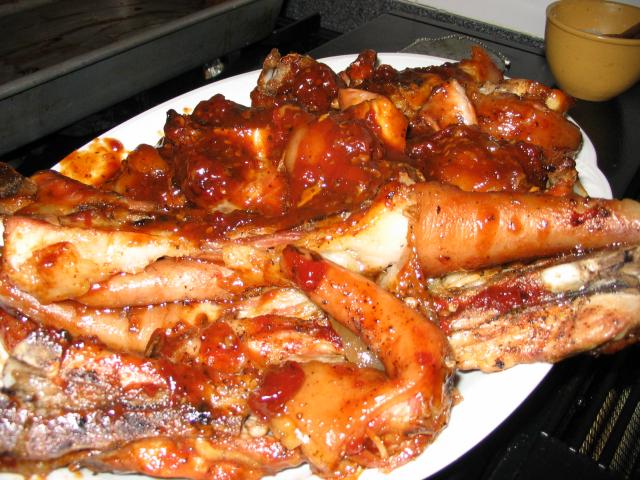
Dianne - are pig's tails an Ontarian thing? The only time I've had them whole like that (or even seen them on a menu) was in either Kitchener or Waterloo (can't remember which).
-
The owner’s wife greets us and says they’d like to cook for us... And the final insult: we were charged for five tasting menus at $90 each.
I don't find anything wrong with bigboss's post.
Nor do I think that a paying customer at a restaurant has to censor or whitewash his comments on eGullet.
As far as his contention that the "we'd like to cook for you" implied that they'd be guests of the restaurant, I think he's entirely in the right. It was entirely misleading. If they meant to charge, they should've said something like, "we'd like to propose a tasting menu which we'll create especially for you, and the cost will be $90 per person". I think the restaurant was in the wrong here.
I also know how bigboss feels, because some years ago I arrived at a fairly upscale and elegant restaurant in Italy on time for a reservation, and they told me "Your table will be a while. Would you care for some Parmiggiano-Reggiano and Champagne on the terrace while you wait?", and when the bill arrived at the end of the meal, there was a $25 charge per person for the champagne and cheese.
I disuputed that with the credit card company and simply refused to pay it.
-
I haven't posted in a while because I haven't cooked in a while (living on really horrible take-out and delivery
 ), but I've been watching here and loving everything you've all been cooking.
), but I've been watching here and loving everything you've all been cooking.Finally, just to be sure I could still work the kitchen, I made duck breast with roasted Cremini mushrooms topped with a dollop of truffled foie-gras, brown and wild rices, and radishes cooked in Maraschino liquer. Naturally we snapped the photo before I poured the pan juices over the duck! (And I managed to get dinner served by 11 pm.
 )
)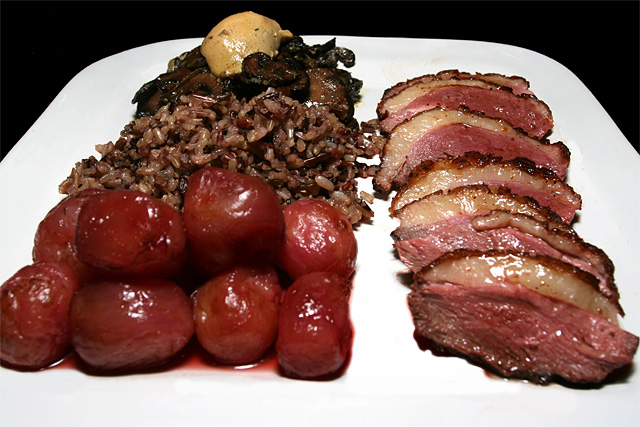
[edited to swap photo]
-
I have found Osterie d'Italia published by Slow Food Italy excellent-it is in Italian, however.
I concur. It is useful even if you don't speak Italian.
That's a great suggestion, thanks. I did some googling and found that an English language version is due out this spring, which is good because it's for some friends of mine who don't speak Italian (I do, and wouldn't mind books in Italian for myself).
I was also hoping that there might be guidebooks that give numerical ratings or use symbols, similar to the many, many such books in France, just for the fun of comparing them, such as the Bottin Gourmand, Gault et Millau, Pudlowski, Guide Routard, etc.
-
Are there any restaurant guides in Italy besides the Gambero Rosso? I assume there must be - I can think of lots for France, but I don't know any for Italy, and would appreciate suggestions.
Also, if anybody knows a book site that will sell and ship them from Italy to the US, that would be most appreciated. Some years ago I learned of www.alapage.fr which is my great source for books in French (takes one minute to order and they arrive in about a week), and I assume there must be a similar Italian bookseller online?
Thanks !!



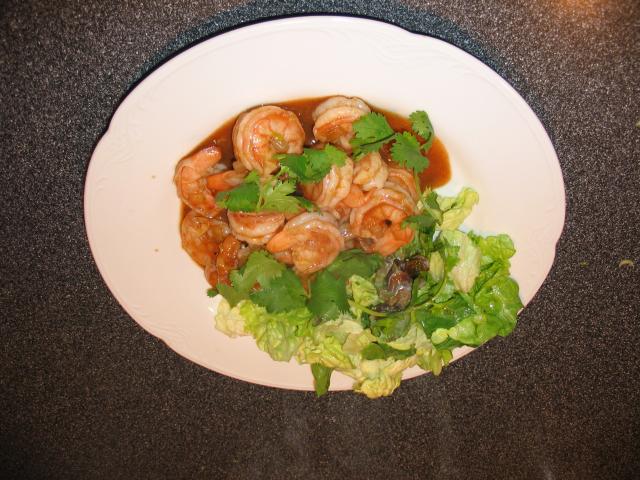
"Tarte Flambée" video
in France: Cooking & Baking
Posted
This springs from a thread about the other bacon and onion tart from Alsace (the one with an egg-custard filling, and a flaky crust). This is the "Tarte Flambée", a rustic, unleavened bread dough rolled paper thin, topped with a creamy blend of Crème Fraîche and Fromage Frais, sprinkled with chunks of bacon (lardons) and thin slices of raw onion, and cooked in a blistering hot oven with raging flames for less than a minute.
The name "Tarte Flambée" comes from the fact that the outside edges are charred by the flames.
Curious to sample one of these, we did some research and learned that it's a country dish, not usually found in cities, and that it's served at "taverns" in the countryside that make it only at night. So, armed with directions from the hotel, we set out on a 13 mile journey out of Strasbourg down smaller and smaller roads, until we came to a village that was no more than a crossroads, and a restaurant with a shack out in the courtyard with the wood burning oven.
After we'd been there a half-dozen times, they not only let us film the entire process, they let me make one (sort of)!
(There's also a dessert version made with apples, and set aflame with Calvados when it comes to the table. I'll post that video later.)
I've posted it in two different video formats (just in case anybody has difficulties with one or the other). Hope you enjoy...
http://www.guyarts.com/tarte-flambee.mp4
http://www.guyarts.com/tarte-flambee.mov